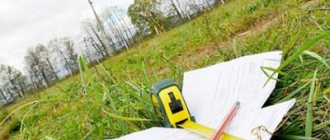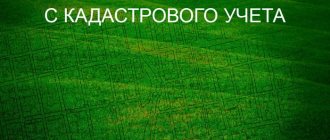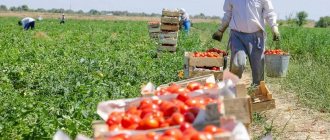Legislation
Issues of relative intended use of land are discussed in Article 7 of the Land Code.
Here the following categories of sites are distinguished:
- lands of the reserve, water, forest fund;
- protected objects and territories;
- areas of the industrial fund (territories that are used in the energy and television industries;
- lands of the defense and space complex;
- agricultural land;
- lands belonging to settlements (including for individual housing construction).
In addition to categories, there are different types of land, determined taking into account regional zoning.
The main types of land owned by Russians are the following: individual housing construction, private plots, gardening and vegetable gardening.
The intended purpose of land is necessarily prescribed in the most important documents: cadastral passport and certificates of ownership (issued before 2021).
You can clarify the permitted use of your land on the public cadastral map.
A separate article of the Land Code obliges all owners to use lands only taking into account their purpose. Unauthorized change of appointment is not allowed, only in agreement with authorized authorities.
Order of the Ministry of Economic Development No. 540 of 2014 contains a detailed list of objects that can be located on the site depending on its intended purpose. So, for example, on a site for individual housing construction it is allowed to build a house no higher than 3 floors. Moreover, it must be intended for residence, and not for conducting business activities (for example, organizing a hotel).
Why do citizens often violate intended use? This is usually due to the desire to save on the purchase of land and taxation. Thus, a plot for individual housing construction will be cheaper than a similar plot allocated for business purposes. Often, shops or tire shops are set up on such lands, which allows owners to reduce the tax base.
Meanwhile, this is a punishable act.
Another common violation: the owner was allocated land for
agriculture, and he built a residential building there. At the same time, he can make some efforts and transfer the category of land from agricultural to individual housing construction. Then the owner will be able to legitimize the buildings.
Violation of the law is punishable by an administrative fine. It is important to note that this applies not only to misuse, but also to non-use of land plots.
How is the fact of misuse of a site established?
The land is under special state control. Compliance with the legal conditions for the use of the site is monitored by a special land supervision committee of Rosreestr and the local administration.
Establishing the fact of misuse of a site can be carried out:
- upon application received from neighbors or the chairman of the SNT (owners of neighboring lands are usually interested in the proper use of land and preventing long-term non-cultivation of plots);
- according to information received from the Federal Tax Service (usually the service is engaged in identifying the fact of illegal business activity) or the prosecutor’s office;
- during an unscheduled inspection of authorized structures etc.
The algorithm for imposing liability for misuse of land consists of the following stages:
- If a fact of misuse (non-use of land) is detected, the owners or authorized structures notify the local branch of Rosreestr. First, they usually try to solve the problem peacefully through negotiations with the owners.
- During the inspection, Rosreestr specialists draw up an inspection report of the land plot and send a demand to the owner with a reasonable period provided for eliminating violations and paying compensation (if there are circumstances indicating the plaintiff’s lost profits).
- If the violation has not been eliminated, then the claim to bring the landowner to administrative liability is referred to the court (Article 7.1, Chapter 7 of the Administrative Code). The drawn up protocol indicates the grounds for use of the land, the location of the site, its category and size; what rules of law were violated by the owner.
- The court makes a decision taking into account whether administrative legislation was actually violated. Based on the results of the consideration of the case, the court opens enforcement proceedings to collect penalties/lost profits or may even confiscate the land from the land user. In this case, it is impossible to seize the land on which the user began to build a house, planted a garden or a vegetable garden.
The landowner will have three days to appeal the court decision.
Fines for unauthorized land seizure
One of the types of illegal actions with plots is their squatting. Responsibility for such actions is provided for in accordance with Article 7.1 of the Code of Administrative Offences. In addition to direct squatting, this article provides for liability for the exploitation of land without proper documents (the basis for performing any actions with it), and the lack of documentary permits for work performed.
An action to use an allotment during which an individual or legal entity should not have prepared documentation regarding the used allotment will not be a violation.
Unauthorized occupation (squatting) may include the following actions:
- carrying out actions to develop a site that does not belong to the developer himself, if he does not have permits to carry out such actions;
- unauthorized change of the boundaries of a site by adding other lands to them, in this case, if permanent construction is also being carried out on someone else’s territory or some temporary structures are being erected. It is worth noting that when plots are confiscated from individuals or organizations, they are not compensated for material damage, since such actions were not initially legal.
Fine for seizure
For violations that are classified as unauthorized seizure, the following fines are imposed (with a known cadastral value, as a percentage of it):
- individual – from 1 to 1.5%, but not less than 5,000 rubles;
- official representatives - from 1 to 1.5%, but at least 20,000 rubles;
- legal entity - from 2 to 3%, but not less than 100,000 rubles.
If the plot in respect of which the violation was committed does not have an established value, then the amount of penalties will be as follows:
- individuals – 5-10,000 rubles;
- company representatives – 20-50,000 rubles;
- legal entity – 100-200,000 rubles.
Punishment and fines
According to the new standards for calculating penalties that are imposed for the illegal exploitation of land, the main parameter on the basis of which the amount of recovery is determined is the cadastral value of the plot damaged by the actions of a person or organization.
If the allotment is used for other purposes, the following penalties are expected:
- for citizens - from 0.5 to 1% of the established value, but not less than 10,000 rubles;
- representatives of organizations - from 1 to 1.5%, but not less than 20,000 rubles;
- for legal entities - from 1.5 to 2% of the value, but not less than 100,000 rubles.
Penalty for inappropriate use
Another principle of calculation will already be present if the site, whose inappropriate use has been recorded, does not have an established cadastral value. In such a situation, the amount of fines may be as follows:
- for individuals – from 10 to 20,000 rubles;
- for representatives of organizations – from 20 to 50,000 rubles;
- for legal entities – from 50 to 100,000 rubles.
Collection in the absence of the fact of using agricultural land
The responsibility for obtaining agricultural land and the further lack of action for their direct use (growing crops) are highlighted separately. In addition to such a violation, persons who do not fulfill the following obligations when receiving land plots may also be held administratively liable:
- carrying out actions for land reclamation;
- improving the properties of the site (its soil);
- protection from harmful insects and weed control;
- hay cut.
Types and stages of reclamation
In the absence of treatment actions, the fine may be:
- for individuals – from 0.3 to 0.5% of the cost of the plot, but not less than 3,000 rubles;
- for official representatives, the fine will range from 0.5 to 1.5%, but not less than 50,000 rubles;
- For legal entities, a fine of 2 to 10%, minimum 200,000 rubles, is provided.
In case of violations that relate to the actions of persons or inaction, which entailed a deterioration in its quality and fertility, the amounts of fines are expressed in the following amounts:
- for individuals – from 20 to 50,000 rubles;
- representatives – 100-200,000 rubles;
- legal entity – from 200 to 400,000 rubles.
So, in cases of actions that fall under the wording of misuse, the persons guilty of such may be held accountable, followed by the imposition of fines. In case of significant deterioration of the properties of the land and failure to restore it, a measure of confiscation of plots in favor of the state may be applied.










